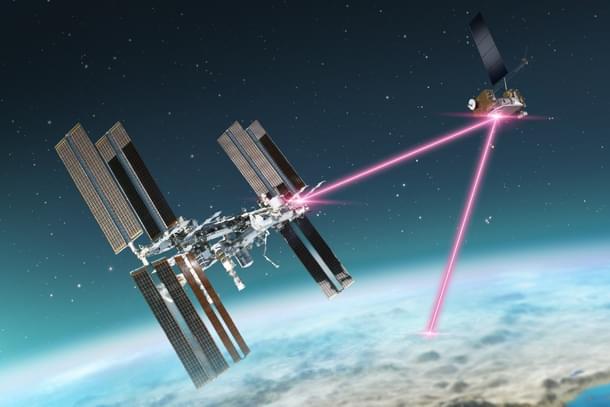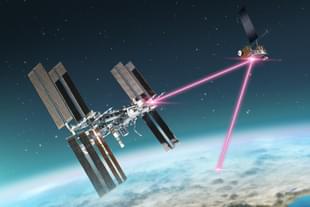Science
Explained: NASA's Endeavours To Expand Future Communications Capabilities For Space Exploration
Swarajya Staff
Aug 12, 2022, 04:42 PM | Updated 05:09 PM IST
Save & read from anywhere!
Bookmark stories for easy access on any device or the Swarajya app.


US space agency NASA is working on using laser-based communications to meet the demand of its future missions for higher and faster data transmission.
Why laser communications
Since its inception, the US space agency has relied on radio frequency (RF)-based communications to meet its data transmission and navigation needs.
However, during the past several decades, the volume of data from NASA’s missions has increased exponentially and is expected to continue at even greater rates.
Although, RF-based communications currently are the most reliable form of space communications, the radio and microwave portions of the electromagnetic spectrum are getting close to capacity.
Laser communications will enable NASA to work within a new, less crowded section of the electromagnetic spectrum.
Another motivation for exploring laser communications is the development of more efficient, cost-effective space communications equipment.
Because RF wavelengths are longer, the size of their transmission beam covers a wider area (about 162 km); therefore, capture antennas for RF data transmissions must be very large.
Laser wavelengths are 10,000 times shorter, allowing data to be transmitted across narrower, tighter beams. The smaller wavelengths of laser-based communications are more secure, delivering the same amount of signal power to much smaller collecting antennas.
Laser communications’ higher data rates will enable exploration and science missions to send more data back to Earth and discover more about the universe.
The communication technology will enable the US space agency to use information from images, video, and experiments to explore not just the near-Earth region, but to also prepare for future missions to Mars and beyond.
New 'Decade of Light'
In 2013, initial data returned from the Lunar Laser Communication Demonstration (LLCD) equipment on NASA's Lunar Atmosphere and Dust Environment Explorer (LADEE) set a space communication bandwidth record when early tests using a pulsed laser beam to transmit data over the 385,000 km (239,000 mi) between the Moon and Earth passed data at a "record-breaking download rate of 622 megabits per second (Mbps)", and also demonstrated an error-free data upload rate of 20 Mbit/s from an Earth ground station to LADEE in Lunar orbit.
Since then, NASA has extended its laser communications endeavours.
“We are thrilled by the promise laser communications will offer in the coming years,” said Badri Younes, deputy associate administrator and program manager for Space Communications and Navigation (SCaN) at NASA Headquarters in Washington, according to a NASA release.
“These missions and demonstrations usher in NASA's new Decade of Light in which NASA will work with other government agencies and the commercial sector to dramatically expand future communications capabilities for space exploration and enable vibrant and robust economic opportunities," Younes added.
Laser Communications Relay Demonstration
On 7 December last year, NASA launched the Laser Communications Relay Demonstration (LCRD) into orbit, about 35,400 km from Earth to test the capabilities of laser communications.
LCRD is the agency’s first technology demonstration of a two-way laser relay system.
In May 2022, NASA certified that LCRD is ready to conduct experiments. These experiments are testing and refining laser systems - the mission’s overall goal.
Experiments provided by NASA, other government agencies, academia, and industry are measuring the long-term effects of the atmosphere on laser communications signals; assessing the technology’s applicability for future missions; and testing on-orbit laser relay capabilities.
“We will start receiving some experiment results almost immediately, while others are long-term and will take time for trends to emerge during LCRD’s two-year experiment period,” said Rick Butler, project lead for the LCRD experimenters program at NASA’s Goddard Space Flight Center in Greenbelt, Maryland.
“LCRD will answer the aerospace industry’s questions about laser communications as an operational option for high bandwidth applications," Butler added.
“The program is still looking for new experiments, and anyone who is interested should reach out,” said Butler.
“We are tapping into the laser communications community and these experiments will show how optical will work for international organizations, industry, and academia," Butler added.
NASA is continuing to accept proposals for new experiments to help refine optical technologies, increase knowledge, and identify future applications.
LCRD will even relay data submitted by the public shortly after its launch in the form of New Year's resolutions shared with NASA social media accounts. These resolutions will be transmitted from a ground station in California and relayed through LCRD to another ground station located in Hawaii as yet another demonstration of LCRD’s capabilities.
TeraByte InfraRed Delivery (TBIRD)
In May this year, NASA launched the TeraByte InfraRed Delivery (TBIRD) payload, as part of the Pathfinder Technology Demonstrator 3 (PTD-3) mission, from Cape Canaveral Space Force Station on SpaceX’s Transporter-5 rideshare mission.
TBIRD will showcase 200-gigabit-per-second data downlinks - the highest optical rate ever achieved by NASA.
TBIRD is continuing NASA’s optical communications infusion by demonstrating the benefits lasers communications could have for near-Earth science missions that capture important data and large detailed images.
TBIRD, which is the size of a tissue box, is sending back terabytes of data in a single pass, demonstrating the benefits of higher bandwidth, and giving NASA more insight into the capabilities of laser communications on small satellites.
“In the past, we’ve designed our instruments and spacecraft around the constraint of how much data we can get down or back from space to Earth,” said TBIRD Project Manager Beth Keer.
“With optical communications, we’re blowing that out of the water as far as the amount of data we can bring back. It is truly a game-changing capability," Keer added.
Integrated LCRD Low-Earth Orbit User Modem and Amplifier Terminal (ILLUMA-T)
In early 2023, NASA is planning to launch the Integrated LCRD Low-Earth Orbit User Modem and Amplifier Terminal (ILLUMA-T) in the Dragon trunk of SpaceX’s 27th commercial resupply services mission to the International Space Station.
ILLUMA-T will bring laser communications to the orbiting laboratory and empower astronauts living and working there with enhanced data capabilities.
It will gather information from experiments aboard the station and send the data to LCRD at 1.2 gigabits per second. At this rate, a feature-length movie could be downloaded in under a minute.
LCRD will then relay this information down to ground stations in Hawaii or California.
“ILLUMA-T and LCRD will work together to become the first laser system to demonstrate low-Earth orbit to geosynchronous orbit to ground communications links,” said Chetan Sayal, project manager for ILLUMA-T at NASA Goddard.
Orion Artemis II Optical Communications System (O2O)
The Orion Artemis II Optical Communications System (O2O) will bring laser communications to the Moon aboard NASA’s Orion spacecraft during the Artemis II mission.
O2O will be capable of transmitting high-resolution images and video when astronauts return to the lunar region for the first time in over 50 years.
Artemis II will be the first crewed lunar flight to demonstrate laser communications technologies, sending data to Earth with a downlink rate of up to 260 megabits per second.
“By infusing new laser communications technologies into the Artemis missions, we’re empowering our astronauts with more access to data than ever before,” said O2O Project Manager Steve Horowitz.
“The higher the data rates, the more information our instruments can send home to Earth, and the more science our lunar explorers can perform," Horowitz added.
Laser communications in deep space
NASA’s laser communications endeavors extend into deep space as well. Currently, NASA is working on a future terminal that could test laser communications against extreme distances and challenging pointing constraints.





